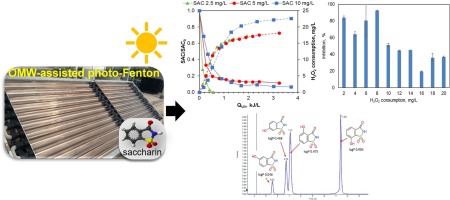当前位置:
X-MOL 学术
›
J. Hazard. Mater.
›
论文详情
Our official English website, www.x-mol.net, welcomes your
feedback! (Note: you will need to create a separate account there.)
Photo-Fenton treatment of saccharin in a solar pilot compound parabolic collector: Use of olive mill wastewater as iron chelating agent, preliminary results.
Journal of Hazardous Materials ( IF 12.2 ) Pub Date : 2018-03-14 , DOI: 10.1016/j.jhazmat.2018.03.016 K Davididou 1 , E Chatzisymeon 1 , L Perez-Estrada 2 , I Oller 2 , S Malato 2
Journal of Hazardous Materials ( IF 12.2 ) Pub Date : 2018-03-14 , DOI: 10.1016/j.jhazmat.2018.03.016 K Davididou 1 , E Chatzisymeon 1 , L Perez-Estrada 2 , I Oller 2 , S Malato 2
Affiliation

|
The aim of this work was to investigate the treatment of the artificial sweetener saccharin (SAC) in a solar compound parabolic collector pilot plant by means of the photo-Fenton process at pH 2.8. Olive mill wastewater (OMW) was used as iron chelating agent to avoid acidification of water at pH 2.8. For comparative purposes, Ethylenediamine-N, N-disuccinic acid (EDDS), a well-studied iron chelator, was also employed at circumneutral pH. Degradation products formed along treatment were identified by LC-QTOF-MS analysis. Their degradation was associated with toxicity removal, evaluated by monitoring changes in the bioluminescence of Vibrio fischeri bacteria. Results showed that conventional photo-Fenton at pH 2.8 could easily degrade SAC and its intermediates yielding k, apparent reaction rate constant, in the range of 0.64-0.82 L kJ-1, as well as, eliminate effluent's chronic toxicity. Both OMW and EDDS formed iron-complexes able to catalyse H2O2 decomposition and generate HO. OMW yielded lower SAC oxidation rates (k = 0.05-0.1 L kJ-1) than EDDS (k = 2.21-7.88 L kJ-1) possibly due to its higher TOC contribution. However, the degradation rates were improved (k = 0.13 L kJ-1) by increasing OMW dilution in the reactant mixture. All in all, encouraging results were obtained by using OMW as iron chelating agent, thus rendering this approach promising towards the increase of process sustainability.
中文翻译:

太阳能先导复合抛物线收集器中糖精的光芬顿处理:使用橄榄磨机废水作为铁螯合剂,初步结果。
这项工作的目的是研究通过光子Fenton工艺在pH值为2.8的条件下,在太阳能复合抛物线收集器中试工厂中处理人造甜味剂糖精(SAC)的方法。橄榄磨废水(OMW)被用作铁螯合剂,以避免pH值为2.8的水被酸化。为了进行比较,在环境pH值下也使用了经过充分研究的乙二胺-N,N-二琥珀酸(EDDS)。通过LC-QTOF-MS分析鉴定了在处理过程中形成的降解产物。它们的降解与毒性去除相关,通过监测费氏弧菌细菌生物发光的变化进行评估。结果表明,pH 2.8的常规光芬顿可以很容易地降解SAC及其中间体,从而产生k,表观反应速率常数在0.64-0.82 L kJ-1范围内,以及 消除废水的慢性毒性。OMW和EDDS均形成了能够催化H2O2分解并生成HO的铁络合物。OMW产生的SAC氧化速率(k = 0.05-0.1 L kJ-1)比EDDS(k = 2.21-7.88 L kJ-1)低,这可能是由于其较高的TOC贡献。但是,通过增加反应混合物中的OMW稀释度可以提高降解速率(k = 0.13 L kJ-1)。总而言之,通过使用OMW作为铁螯合剂获得了令人鼓舞的结果,从而使该方法有望提高工艺的可持续性。通过增加反应混合物中OMW的稀释度可以提高降解率(k = 0.13 L kJ-1)。总而言之,通过使用OMW作为铁螯合剂获得了令人鼓舞的结果,从而使该方法有望提高工艺的可持续性。通过增加反应混合物中的OMW稀释率可以提高降解率(k = 0.13 L kJ-1)。总而言之,通过使用OMW作为铁螯合剂获得了令人鼓舞的结果,从而使该方法有望提高工艺的可持续性。
更新日期:2019-03-13
中文翻译:

太阳能先导复合抛物线收集器中糖精的光芬顿处理:使用橄榄磨机废水作为铁螯合剂,初步结果。
这项工作的目的是研究通过光子Fenton工艺在pH值为2.8的条件下,在太阳能复合抛物线收集器中试工厂中处理人造甜味剂糖精(SAC)的方法。橄榄磨废水(OMW)被用作铁螯合剂,以避免pH值为2.8的水被酸化。为了进行比较,在环境pH值下也使用了经过充分研究的乙二胺-N,N-二琥珀酸(EDDS)。通过LC-QTOF-MS分析鉴定了在处理过程中形成的降解产物。它们的降解与毒性去除相关,通过监测费氏弧菌细菌生物发光的变化进行评估。结果表明,pH 2.8的常规光芬顿可以很容易地降解SAC及其中间体,从而产生k,表观反应速率常数在0.64-0.82 L kJ-1范围内,以及 消除废水的慢性毒性。OMW和EDDS均形成了能够催化H2O2分解并生成HO的铁络合物。OMW产生的SAC氧化速率(k = 0.05-0.1 L kJ-1)比EDDS(k = 2.21-7.88 L kJ-1)低,这可能是由于其较高的TOC贡献。但是,通过增加反应混合物中的OMW稀释度可以提高降解速率(k = 0.13 L kJ-1)。总而言之,通过使用OMW作为铁螯合剂获得了令人鼓舞的结果,从而使该方法有望提高工艺的可持续性。通过增加反应混合物中OMW的稀释度可以提高降解率(k = 0.13 L kJ-1)。总而言之,通过使用OMW作为铁螯合剂获得了令人鼓舞的结果,从而使该方法有望提高工艺的可持续性。通过增加反应混合物中的OMW稀释率可以提高降解率(k = 0.13 L kJ-1)。总而言之,通过使用OMW作为铁螯合剂获得了令人鼓舞的结果,从而使该方法有望提高工艺的可持续性。











































 京公网安备 11010802027423号
京公网安备 11010802027423号